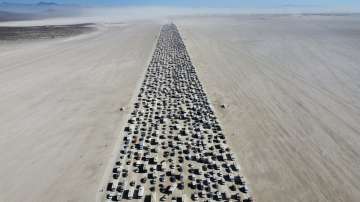The Burning Man festival of music and culture came to an end on Monday, in Nevada, United States of America. This turned into the first Burning Man festival after three years of COVID delays. At least 80,000 attendees had reached the venue for the nine-day festival. After the festival was over, those leaving the Black Rock Desert found themselves stuck in a traffic jam for more than eight hours as thousands of vehicles lined up at the same time to return.
The pictures have been published by the revellers and showed 15 lanes of bumper-to-bumper traffic for miles. The pictures have gone viral on social media.
Burning Man's official Twitter account also tweeted on Monday said, "Exodus wait time is currently around eight hours. Consider delaying your departure until conditions improve."
Read: Viral video: Pet dog mercilessly attacks man in Noida's housing society lift | WATCH
One user, sharing the photo of the jam in the caption, wrote, “Though human beings like examining the Burning guy aesthetic to Mad Max… the Exodus from the camp is the maximum Mad Max I actually have felt all week… 5 hours in, greater until I reach the exit gate (sic).”
As the Burning Man festival was held ahead of Labor Day, people travelled from across the globe in huge numbers. The festival closed with the burning of an effigy, known as The Burning Man. This has been the conventional manner to shut the festival since its inauguration in 1989.
Read: House of The Dragon CGI goof-up reminds netizens of Game of Thrones Starbucks cup, see reactions
History of The Burning Man festival
Burning Man was inaugurated in 1986, while Larry Harvey and Jerry James, individuals of the San Francisco arts community, burned an eight-foot- (-metre-) tall wooden effigy of a manon San Francisco’s Baker Beach in the celebration of the summer solstice. Twenty humans witnessed the event. Over the next four years Harvey and James (and ever-increasing crowds) returned to the site with an increasing number of taller effigies.

